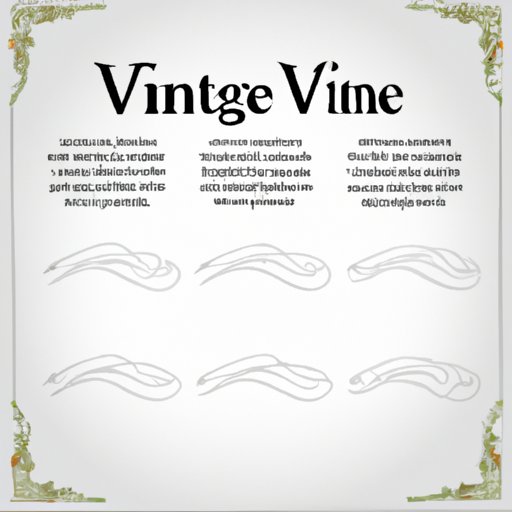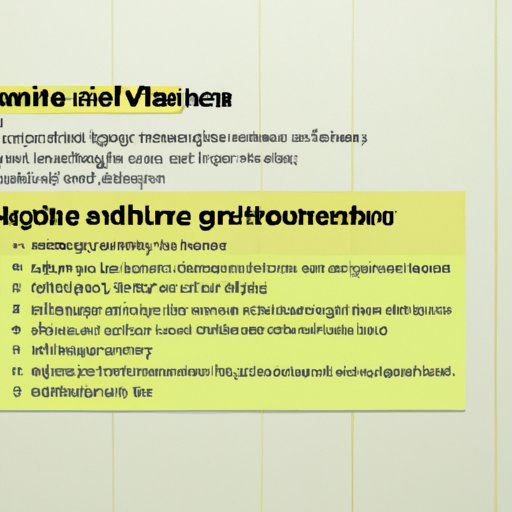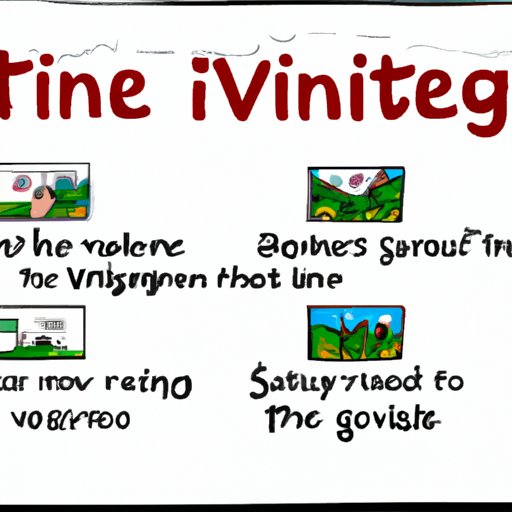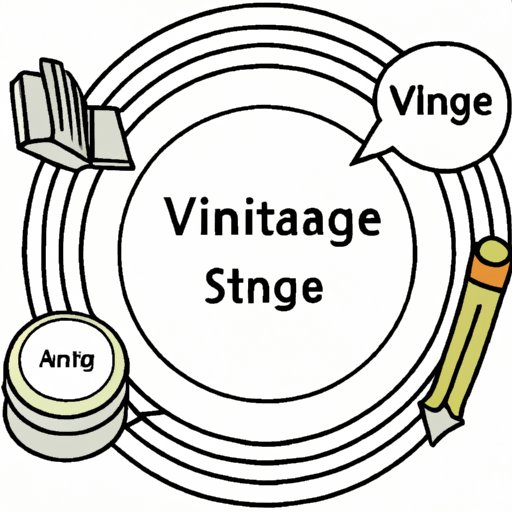Introduction
A vignette is a short piece of writing that focuses on a single subject or moment. It typically evokes a particular emotion or atmosphere, and often uses vivid imagery and sensory details to create a strong impression. Vignettes are used in both fiction and non-fiction forms of writing, and can be used to enhance characterization and plot development. In this article, we’ll explore what a vignette is in writing, analyze examples from classic and contemporary literature, and provide tips for crafting your own vignettes.
Definition of a Vignette in Writing
The term “vignette” comes from the French word “vigne” meaning “little vine”. It was originally used to refer to a decorative border around a painting, but later came to refer to a brief scene or description in literature. A vignette is a snapshot of a moment in time, usually focusing on one particular event, object, or character. It is typically written in a concise, descriptive style and often evokes a certain emotion or atmosphere.

Purpose of Writing Vignettes
Vignettes can be used for many different purposes in writing. They can be used to introduce a character or setting, evoke a certain emotion, or provide insight into a particular moment. Vignettes are also a great way to add depth and interest to a story. By focusing on a specific moment, they can draw readers in and encourage them to connect with the characters and plot development.
Crafting a Vignette: Tips for Writers
Writing a successful vignette involves more than just describing a scene or character. Here are some tips for crafting a compelling vignette:
Identifying the Focus of Your Vignette
Before you begin writing, it’s important to decide what the focus of your vignette will be. Ask yourself questions such as: What is the overall tone of the vignette? What emotions do I want to evoke? What characters and settings should be included? Once you have identified the focus of your vignette, you can start to craft a compelling narrative arc.
Creating an Engaging Setting and Atmosphere
The setting and atmosphere of your vignette should be carefully crafted to help create the desired mood. Use sensory details such as sight, sound, smell, taste, and touch to bring the scene to life. Consider the time of day, the weather, and any other elements that will help to create a vivid and immersive atmosphere.
Establishing a Specific Tone
The tone of your vignette should reflect the overall theme and emotion of the piece. Think about words and phrases that will help to convey the desired feeling. For example, if you are writing a vignette about a bittersweet goodbye, you may want to use words that evoke sadness or nostalgia.
Crafting Dialogue and Character Development
Dialogue is an important element of any vignette, as it can help to bring characters to life and develop the plot. Make sure to include only necessary dialogue that adds to the story, and avoid long, rambling conversations. You should also use dialogue to reveal aspects of a character’s personality or backstory.
Crafting a Narrative Arc
A good vignette should have a beginning, middle, and end. Start by introducing the characters and setting, then move on to the main action or event. Finally, include a conclusion that resolves the story. This will help to give the vignette structure and make it more engaging for readers.

Analyzing Examples of Vignettes in Literature
Now that you know the basics of crafting a vignette, let’s take a look at some examples from classic and contemporary literature. These examples will help to illustrate how vignettes can be used to enhance characterization and plot development.
Examples from Classic Literature
One of the most famous examples of a vignette in literature is from Charles Dickens’ novel Great Expectations. In this passage, Pip describes his initial meeting with the convict Magwitch: “He was a fearful man, all in coarse gray, with a great iron on his leg. A man with no hat, and with broken shoes, and with an old rag tied round his head. A man who had been soaked in water, and smothered in mud, and lamed by stones, and cut by flints, and stung by nettles, and torn by briars; a man who limped, and shivered, and glared, and growled; and whose teeth chattered in his head as he seized me by the chin.” The vivid imagery and sensory details of this passage help to set the scene and create a powerful impression.
Examples from Contemporary Fiction and Non-Fiction
Vignettes can also be found in contemporary fiction and non-fiction. For example, in J.K. Rowling’s Harry Potter series, a vignette is used to introduce the character of Hagrid: “He was a giant of a man, at least twice as tall as a normal man and three times as wide. He had a face as big as a ham – pale-green eyes and a long, tangled beard. He wore enormous boots, and a crossbow was slung over his shoulder.” The description of Hagrid’s size and appearance helps to create an immediate impression of him, and sets the stage for further character development.

Understanding the Power of Vignettes in Storytelling
Vignettes can be a powerful tool for storytelling, as they can add depth and interest to your writing. Let’s take a look at some of the ways that vignettes can enhance characterization and plot development.
Adding Depth and Interest to Your Writing
By focusing on a specific moment, a vignette can add depth and interest to a story. It can provide readers with a glimpse into a character’s background or motivations, or give an insight into a particular situation. This can help to draw readers in and keep them engaged with the story.
Enhancing Characterization and Plot Development
Vignettes can also be used to enhance characterization and plot development. They can provide readers with a better understanding of a character’s feelings and motivations, and help to move the story along. Vignettes can also be used to introduce new characters or settings, and to provide clues about future events.
Encouraging Reader Engagement
Vignettes can be used to encourage reader engagement by making them feel connected to the characters and story. By providing vivid imagery and sensory details, a vignette can help readers to visualize the scene and become immersed in the story. This can make the story more enjoyable and memorable for readers.
A Guide to Writing Vignettes for Fiction and Non-Fiction
Writing a successful vignette requires creativity, originality, and attention to detail. Here are some tips for crafting a unique and engaging vignette for fiction and non-fiction:
Crafting a Unique Voice
Your vignette should have its own distinct voice and style, so make sure to use language that reflects your own personal writing style. Avoid cliches and generic phrases, and try to find your own unique way of expressing your ideas.
Creating a Cohesive Scene
When crafting a vignette, it’s important to create a cohesive scene. Make sure to include only necessary details that add to the overall story, and avoid including too much extraneous information.
Developing Original Ideas
Your vignette should be based on original ideas and concepts. Think outside the box and come up with creative ways to express your ideas.
Editing and Revising Your Vignette
Once you have finished writing your vignette, it’s important to edit and revise it to ensure that it meets the desired standards. Read through your vignette several times to check for grammar and spelling errors, and make sure that the structure and flow are clear and logical.
Conclusion
In this article, we explored what a vignette is in writing, analyzed examples from classic and contemporary literature, and provided tips for crafting your own vignettes. We also discussed the power of vignettes in storytelling, and how they can be used to add depth and interest to your writing. Finally, we provided a guide to writing vignettes for fiction and non-fiction.
Vignettes are a powerful tool for writers, and can help to create an engaging and immersive experience for readers. Whether you are writing a novel or a non-fiction piece, vignettes can be used to add depth and interest to your story. With practice and dedication, you can master the art of crafting a compelling vignette.
(Note: Is this article not meeting your expectations? Do you have knowledge or insights to share? Unlock new opportunities and expand your reach by joining our authors team. Click Registration to join us and share your expertise with our readers.)
